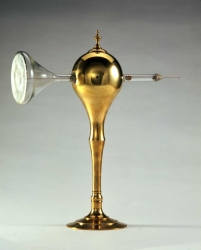Scientific Instrument Society 25th Anniversary Exhibition
Navigation:
<< First | < Previous | Next > | Last >>
48 The Perméomètre Reconstructed
Prior to the political journalism that brought him notoriety during the French Revolution, Jean Paul Marat (1743-1793) practised as a physician before launching a career as a natural philosopher. This instrument is a reconstruction of one of the (lost) devices that Marat used in a series of electrical researches published in 1782.
Marat was seeking to visualise the character and operation of the “electrical fluid”, considered at the time as the cause of electrical action. The brass ball is filled with salty water and the end of the glass phial covered with tin foil is brought near the prime conductor of an electrical machine. Marat sought to investigate the stream of electrical fluid emanating from the conductor and, when viewed in a darkened room, he reported luminous effects on and within the phial.
After a promising start, Marat’s work was rejected by the Académie des Sciences in Paris. His scientific reputation also suffered from association with his subsequent revolutionary career. Working with replica apparatus makes it possible to reinstate at least the accuracy of Marat’s experimental reports. In practice the perméomètre does show the kinds of effects described by Marat: greenish light spreading from the bottom of the phial and sparks around the tip of the brass rod within it. It also helps to recover Marat’s style of research, which was focused on visualising phenomena – whether of fire, light or electricity.
This reconstruction of Marat’s perméomètre was built in the Physics Department of Carl-von-Ossietzky Universität, Oldenburg, Germany. Its creation was part of a larger programme of instrumental reconstruction and experimental replication carried out by the University’s Research Group on Higher Education and History of Science.
Collection: Peter Heering, Oldenburg University
S.J.
See: J.P. Marat, Recherches Physiques sur l’Élecricité, Paris 1782.
Bulletin of the Scientific Instrument Society, No. 74 2002, pp. 8-15

